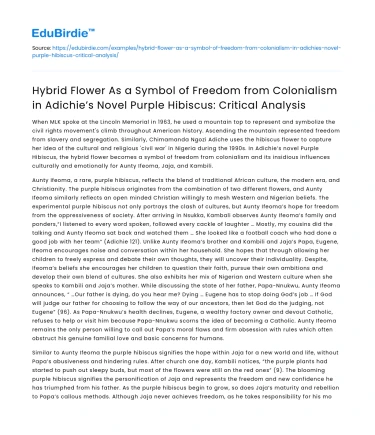When MLK spoke at the Lincoln Memorial in 1963, he used a mountain top to represent and symbolize the civil rights movement's climb throughout American history. Ascending the mountain represented freedom from slavery and segregation. Similarly, Chimamanda Ngozi Adiche uses the hibiscus flower to capture her idea of the cultural and religious 'civil war' in Nigeria during the 1990s. In Adichie’s novel Purple Hibiscus, the hybrid flower becomes a symbol of freedom from colonialism and its insidious influences culturally and emotionally for Aunty Ifeoma, Jaja, and Kambili.
Aunty Ifeoma, a rare, purple hibiscus, reflects the blend of traditional African culture, the modern era, and Christianity. The purple hibiscus originates from the combination of two different flowers, and Aunty Ifeoma similarly reflects an open minded Christian willingly to mesh Western and Nigerian beliefs. The experimental purple hibiscus not only portrays the clash of cultures, but Aunty Ifeoma’s hope for freedom from the oppressiveness of society. After arriving in Nsukka, Kambali observes Aunty Ifeoma’s family and ponders,“I listened to every word spoken, followed every cackle of laughter … Mostly, my cousins did the talking and Aunty Ifeoma sat back and watched them … She looked like a football coach who had done a good job with her team” (Adichie 121). Unlike Aunty Ifeoma’s brother and Kambili and Jaja’s Papa, Eugene, Ifeoma encourages noise and conversation within her household. She hopes that through allowing her children to freely express and debate their own thoughts, they will uncover their individuality. Despite, Ifeoma’s beliefs she encourages her children to question their faith, pursue their own ambitions and develop their own blend of cultures. She also exhibits her mix of Nigerian and Western culture when she speaks to Kambili and Jaja’s mother. While discussing the state of her father, Papa-Nnukwu, Aunty Ifeoma announces, “ …Our father is dying, do you hear me? Dying … Eugene has to stop doing God’s job … If God will judge our father for choosing to follow the way of our ancestors, then let God do the judging, not Eugene” (96). As Papa-Nnukwu’s health declines, Eugene, a wealthy factory owner and devout Catholic, refuses to help or visit him because Papa-Nnukwu scorns the idea of becoming a Catholic. Aunty Ifeoma remains the only person willing to call out Papa’s moral flaws and firm obsession with rules which often obstruct his genuine familial love and basic concerns for humans.
Similar to Aunty Ifeoma the purple hibiscus signifies the hope within Jaja for a new world and life, without Papa’s abusiveness and hindering rules. After church one day, Kambili notices, “the purple plants had started to push out sleepy buds, but most of the flowers were still on the red ones” (9). The blooming purple hibiscus signifies the personification of Jaja and represents the freedom and new confidence he has triumphed from his father. As the purple hibiscus begin to grow, so does Jaja’s maturity and rebellion to Papa’s callous methods. Although Jaja never achieves freedom, as he takes responsibility for his mother’s crime, the purple hibiscus still signifies the hope and growth he unveils through his journey of defiance. However, after the death of Papa, Jaja remarks, “Of course God does …Why did He have to murder his own son so we would be saved? Why didn’t He just go ahead and save us?” (289). Both Jaja and his sister, Kambili, escape Papa’s stern control, but individually embrace their newly established freedom in different manners. Jaja begins to look at the Catholic Church as a system of domination while Kambili continues to imitate her father’s style of Chrisitanity. Similarly to Papa’s conservative black and white thinking, Jaja inhibits a more liberal black and white way of thinking, as he rejects Catholisim entirely and closes his mind to the positive aspects of the religion. Jaja begins to essence his father’s single mindedness and pursue a life estrange from his own sister, mother and traditional African culture.
Unlike her brother, Jaja, Kambili becomes a rare, purple hibiscus by the end of the novel. While watching Father Adichie help children exercise, Kambili utters, “It was different for Jaja and me. We did not scale the rod because we believed we could, we scaled it because we were terrified that we couldn’t” (226). Kambili comes to the realization that the rod symbolizes the different ways a child can be raised. She’s been brought up by a malicious, tyrannical parent who uses physical and mental abuse to help her succeed in life. Kambili recognizes the effectiveness of Aunty Ifeoma’s nurturing and loving strategy compared to her father’s degrading and abusive approach to raising children. She admires her strong and self-motivated Aunt and aspires to be like her, a rare, purple hibiscus. Similarly to Aunty Ifeoma, Kambili finds a blend between Western and Nigerian beliefs. While on Pilgrimage with her family, Kambili says, “And then I saw her, the Blessed Virgin: an image in the pale sun, a red glow on the back of my hand … She was everywhere” (274). Kambili confirms her faith through pilgrimage and comes to the conclusion that Christianity will always remain an essential part of her life despite her father’s misinterpretation of it. She embraces her Aunt’s ability to combine her Catholic beliefs and Nigerian culture as one cohesive adapting lifestyle. Through her newly found independence and freedom Kambili finds a way to incorporate religion within her new identity and becomes a rare, hybrid purple hibiscus.
Throughout the novel, purple hibiscus symbolizes Aunty Ifeoma, Jaja, and Kambili’s desire for freedom and hope. For Jaja the purple hibiscus represents his growth and maturity. While the purple hibiscus for Aunty Ifeoma and Kambili personifies their hybridity between Catholicism, the modern era, and Nigerian culture.






 Stuck on your essay?
Stuck on your essay?

